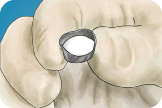Acero Crowns Stainless Steel Users Guide

BASIC SET UP: ACERO MOLAR KIT, KETAC CEMENT, MIXING PAD, SPATULA, HOWE PLIER, CRIMPERS.

HOWE PLIER USED TO FLATTEN INTERPROXIMAL SURFACE (IF NECESSARY).

CRIMPERS TO MODIFY CROWN MARGINS FOR SNUGGER FIT (IF NECESSARY).

KETAC FILLED CROWN READY TO BE CEMENTED.
-
Local Anesthesia
Local anesthesia is generally required and the use of a rubber dam strongly recommended.
-
Reduce the occlusal height
Using a tapered fissure bur, produce pilot or guide cuts. Connect the cuts and thus create a uniform occlusal reduction of 1.5 mm. This should reflect the shape of the original tooth.
-
Reduce mesial and distal proximal surfaces
Slice directly through the proximal surface. Starting from the buccal surface, reduce or eliminate the contact without creating a ledge in the proximal space and/or damaging the approximating tooth. Switch to the distal surface and perform the same procedure.
The margin should be knife edge With no ledges and approximately 1.0 mm subgingival. Little or no reduction is required for the buccal and lingual surfaces. -
Remove all existing caries.
-
Smooth all line angles
When multiple adjacent teeth are being prepared, greater interproximal reduction is required for easier crown placement.
Through a perioprobe or other explorer slide through the proximal surface to ensure there is no contact.
Preparation should be occlusally square. -
Crimp and contour
Crimping and contouring involves bending the gingival one-third of the crown's margins inward to establish a tight marginal fit and adaptation.
-
Cement crown
Dry the tooth and crown. Fill the crown approximately two-thirds full with glass ionomer so that excess cement will flow out from the margins preventing any voids. Spray off excess cement with air and water. An explorer can be used to check for and remove any residual cement along with a knotted floss for interproximal areas.
Seat crown completely. -
Remove excess cement.
-
Rinse and floss interproximal areas.
-
Check occlusion.
Optional Steps and Tips
The crown will need trimming if it causes too much gingival blanching. Use curved crown and bridge scissors or an abrasive stone to trim. After trimming, crimp the margins with crimping pliers. The margins can be finished smooth with a heatless stone and rubber wheel.
When restoring a primary second molar in a patient whose permanent first molar hasn’t erupted, ensure that the distal crown margin does not overhang excessively and thus impede the eruption path of the permanent first molar. Use the smallest possible crown with good distal margin adaptation. A post-op bitewing will verify a clear eruption path.
Due to likely interproximal space loss, it can be challenging to fit two crowns side by side when restoring two adjacent molar teeth with significant interproximal caries. More tooth preparation is needed on the mesial and distal surfaces to accommodate for the space loss and allow placement of a smaller crown. After the teeth are prepared, flatten the mesial and distal sides of the crowns with a Howe plier. This way two crowns can be seated in the diminished mesial-distal space. Alternative option is to use our ACERO NARROW CROWNS.
